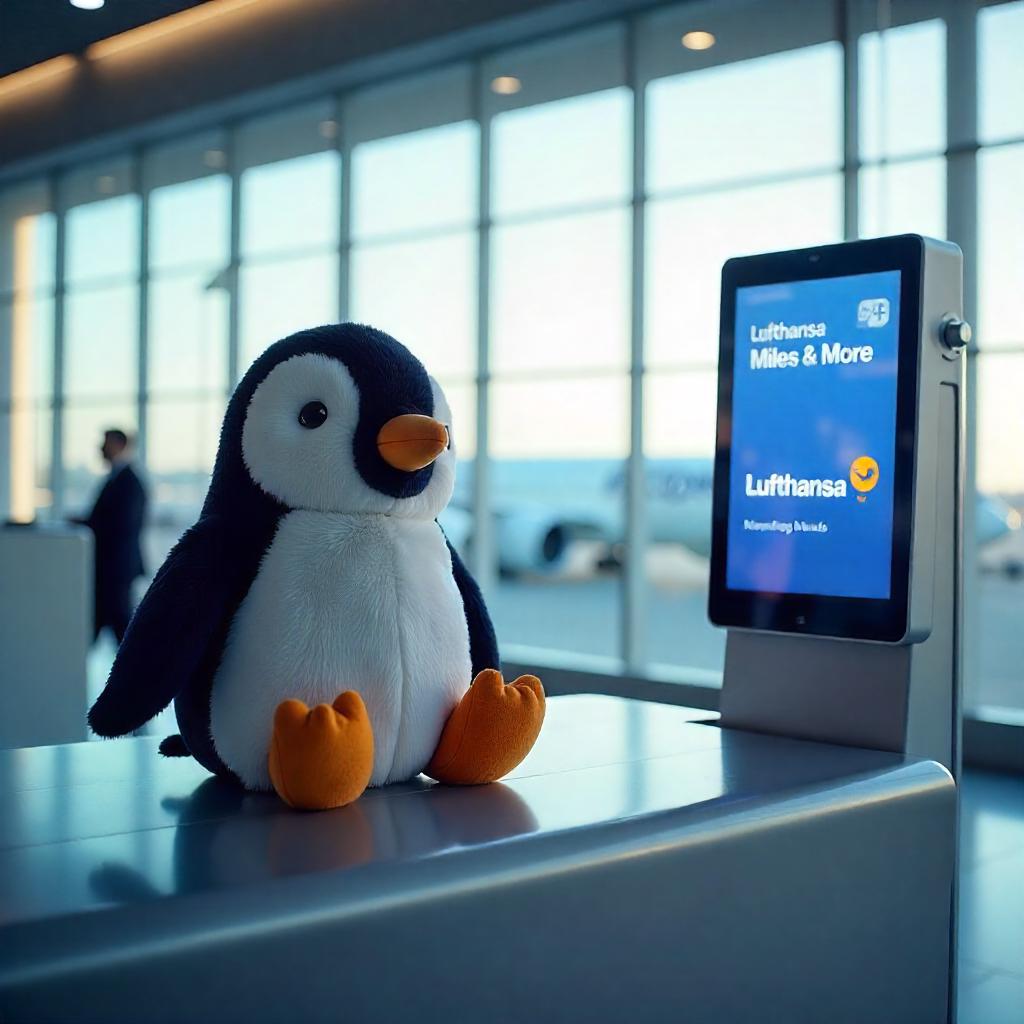Imagine earning real-world airline miles every time you buy a fun Pudgy Penguin plush or digital collectible. That’s exactly what’s happening now, thanks to an unexpected but genius twist: Pudgy Penguins has teamed up with Lufthansa’s Miles & More, Europe’s biggest frequent flyer program. This isn’t just a quirky Web3 stunt. It’s a bold stride in loyalty innovation—transforming NFT purchases into tangible travel rewards.
This partnership lets members of “The Huddle,” Pudgy’s devoted community, earn airline miles for every purchase in the Pudgy Shop, whether they pay in fiat currency or in PENGU tokens. These miles aren’t just redeemable for flights—they unlock access to more than 300 partners in the Miles & More network, from hotels to experiences. Suddenly your adorable NFT becomes a ticket to real adventures.
Launching this program when PENGU token prices were testing key support levels wasn’t accidental. The move adds utility to the token, giving users an entirely new reason to shop—and hold—beyond speculation. But it’s more than just tokenomics. It marks a meaningful shift: NFTs aren’t only memeable JPEGs—they’re earning you flights.
Over the next sections, we’ll unpack exactly how this bridge between digital ownership and real-world utility came together, why it matters for brand managers, and how it might change the way companies think about loyalty programs in the Web3 era.
Context and Background
Pudgy Penguins began as a vibrant, meme-inspired NFT collection, launching in August 2021 with 8,888 unique, hand-drawn penguins. Quickly, the project cultivated “The Huddle”—a deeply engaged community that energized the brand as a cultural force in Web3. Over time, Pudgy expanded far beyond just digital art, branching into merchandise, games, and branded hardware wallets to establish a multidimensional presence.
Lufthansa’s Miles & More is Europe’s premier frequent-flyer program, boasting millions of active users and partnerships with more than 300 airlines, hotels, rental car companies, and lifestyle experiences. It stands firmly as a trusted, mainstream loyalty leader.
In June 2025, these two seemingly disparate brands surprised the Web3 sphere by joining forces. Pudgy Shop customers—whether paying in fiat or PENGU tokens—can now earn Miles & More points directly through routine purchases. Users create or log in to their accounts on both platforms, click a simple pop-up in Pudgy Shop, and subsequent transactions automatically generate airline miles in your account. This is one of the first instances where a major airline loyalty program has plugged directly into an NFT-native brand’s storefront.
But this move wasn’t just promotional flair. At the time of the announcement, PENGU was grappling with technical pressure, trading near a critical support zone between $0.0090 and $0.0093. With price indicators like MACD and RSI signaling a downturn, Pudgy’s integration with Lufthansa aimed to shift focus from speculative volatility to real-world value. The narrative pivoted—PENGU wasn’t just a collectible; it was a token that paid for plush toys and contributed toward your next flight.
This alliance crystallizes a broader transition: NFTs evolving from hype-driven JPEGs to assets with tangible utility. For brand managers, it’s an instructive case. It showcases how a cultural internet brand can unlock real-world partnerships that amplify loyalty, drive token use, and raise the bar in customer engagement strategies across industries.
Partnership Mechanics
Let’s break down exactly how Pudgy Penguins and Lufthansa engineered this innovative loyalty integration in a way that’s intuitive and seamless for users.
Setting things up starts with two simple steps. First, you sign up for a Miles & More account if you don’t already have one. Then, head to the Pudgy Shop, create your account there, and select the option to link your Miles & More credentials via a dedicated pop-up during checkout. Once you make that link, every transaction—whether it’s fiat or PENGU tokens spent—automatically generates Lufthansa miles in your account.
This two-step process ensures the user experience feels familiar rather than jarringly new. You don’t need to manually claim miles or jump through hoops after each purchase—the system credits your account in the background. This automatic crediting makes it feel just like any other flight purchase, except now your merch spend also counts toward travel.
From a technical and strategic lens, this is a groundbreaking moment. It’s one of the first times a major legacy loyalty program—Lufthansa Miles & More—has integrated directly with an NFT-centric brand’s retail operation. That level of plug-and-play interoperability is rare, especially given the dual-payment flexibility. You can use traditional money or crypto tokens, and still get miles. This gives the PENGU token real spend and earn utility, converting it from a speculative asset into something with everyday value.
Imagine paying with PENGU for a Pudgy plush and instantly stacking up travel points. Those points can be used across 300+ partners—from flights to hotels to car rentals. This stretches the token’s allure far beyond hype; it breeds real incentives to accumulate and spend responsibly.
This isn’t just a loyalty gimmick—it’s a low-friction model that turns each sale into a utility-driven interaction. By folding miles directly into transactions, the partnership avoids the usual friction of pseudo crypto rewards. It bridges lifestyle and travel tangibly. For brand managers, this is the blueprint: simplify the experience, create crossover appeal, and embed utility in everyday actions.
Utility Expansion for PENGU Token
Let’s dive into what this partnership does to the PENGU token—how it evolves from a speculative asset into a functional currency that users actually want to hold and spend.
Before this partnership, PENGU was a charming token with community appeal, rooted in airdrops and brand loyalty. It launched on Solana with 88.88 billion tokens, routed to holders, the treasury, and marketing wallets. That established PENGU as more than just a collectible—it was already positioned as a utility token with broader ecosystem ambitions.
The Lufthansa tie-up is a pivotal shift. Now PENGU holders aren’t just collecting it—they can spend it. And that spending transforms into real miles across a global loyalty network. Users earn miles even when shopping in fiat—but the inclusion of PENGU payments means token holders gain equivalent benefits, a true unlock of spend-and-earn utility.
Imagine paying with PENGU for a Pudgy plush and instantly stacking up travel points. Those points can be used across 300+ partners—from flights to hotels to car rentals. This stretches the token’s allure far beyond hype; it breeds real incentives to accumulate and spend responsibly.
PENGU was hovering in a narrow price band of $0.0090 to $0.0093—a crucial technical zone marked by support and an ascending trendline. Around this same time, the token broke below its 20-day EMA, triggering bearish MACD and RSI signals nearing 40. Without a clear catalyst, investors could lose interest and shift attention elsewhere.
Enter utility. By adding the ability to earn Lufthansa miles, PENGU trades its role as a speculative asset for that of a consumable token with tangible benefits. It’s not just about price anymore—it’s about purpose and user motivation. Every token spent or held now carries dual value: financial upside and travel reward potential.
The result is stronger retention. Users won’t just buy PENGU because they hope it spikes; they’ll hold it because it lets them travel, stay, or dine. And this subtle shift in token dynamics can buoy liquidity, stabilize pricing, and deepen community engagement.
Strategic Implications for Brand Managers
This collaboration between Pudgy Penguins and Lufthansa isn’t just cute schwag; it’s a strategic masterstroke in loyalty marketing—here’s why:
Linking a digital-native brand to a legacy airline chain puts Pudgy Penguins into mainstream relevance. When your community makes a purchase—whether digital or tangible—they’re not just collecting merchandise, they’re unlocking real travel benefits. It’s a round-the-clock reminder that their engagement has value beyond entertainment. That emotional “I earned miles” feeling builds loyalty in a way most NFT drops can’t.
This model also supports cross-industry synergies. For airline brands, it opens access to younger audiences, Web3 natives and cultural trendsetters. For digital brands, it taps into mature systems with millions of users. Brand managers in adjacent industries can replicate this: imagine a streaming platform offering miles for subscriptions, or a fashion brand tying tokens to hotel rewards.
Operationally, the execution is low-friction—users link accounts once. Transactions credit miles automatically. The simplicity reinforces brand credibility. Unlike token sandboxes that require manual claiming or blockchain savvy, this feels customary: “I shopped, I got miles.” That user experience alignment increases conversion and repeat purchase, making loyalty feel seamless.
On the PENGU side, this alliance transcends hype. In June 2025, the token hovered between $0.0090 and $0.0093—a critical confluence zone where bearish momentum could have suppressed community interest. But introducing airline miles shifts the dialogue. Discussions in Telegram or Discord are no longer just “What will PENGU price do?” but “How many miles have you earned?” That’s design-forward engagement.
For brand managers, this is a template: drive loyalty by creating real-world impact tied to everyday actions. Engage fans in new ecosystems. Layer emotional rewards onto commercial transactions. And make sure that integration is seamless and meaningful—otherwise it’s just noise.
KPIs and Outcome Metrics to Track
To truly assess the value of this Pudgy Penguins–Lufthansa integration, brand managers must track purposeful metrics that move beyond vanity numbers. This is not just about seeing who clicked or purchased, but understanding long-term impact across user behavior, token engagement, and loyalty lifecycle.
The first key metric is enrollment rate. This tracks how many Pudgy Shop customers link their Miles & More accounts. A strong benchmark offers visibility into how compelling the value proposition is—are people willing to make the connection between merch and miles?
Then there’s the active engagement rate—measuring what portion of those linked users actually go on to complete qualifying purchases. This highlights how well the program moves users from passive interest to repeated action.
Another is the reward redemption rate. Do users actually redeem the miles they earn through these purchases? High redemption means they see value; low redemption could point to poor communication or a clunky redemption process.
The average order value is also essential. Are users spending more per transaction once the miles incentive is introduced? If so, the program isn’t just engaging—it’s upselling.
Track customer retention and frequency. The goal here is simple: are users returning to make additional purchases, and how often? If loyalty is working, that number climbs.
Dig into customer lifetime value. If this number increases post-integration, it signals a deeper emotional and transactional relationship with the brand—one where users are engaged over time, not just for a single plush drop.
You also want to measure Net Promoter Score among linked users. This helps reveal user satisfaction and likelihood to recommend the program, which often correlates with organic growth.
On the blockchain side, observe token velocity and circulation. Is PENGU moving more actively? Are more users spending and earning with it rather than hoarding? If yes, that’s a sign of healthy token utility.
Then, weigh cost-to-benefit efficiency. Are the rewards paid out in miles worth the revenue generated? This lets brands tweak the reward model to keep it profitable and scalable.
Lastly, assess redemption source ratio. Are users spending miles on flights, hotels, experiences, or something else? Knowing where they find the most value can inform future partnerships or targeted campaigns.
Establishing baselines for each of these metrics allows for A/B testing. You can compare outcomes between users who have linked their Miles & More account and those who haven’t. This provides concrete data on how much of your sales growth, retention, and satisfaction are being driven by the loyalty tie-in specifically.
With these metrics, brands don’t just guess—they know. And when these numbers move in the right direction, it confirms that integrating loyalty with digital assets is more than buzz—it’s a breakthrough.
Challenges and Considerations
While the Pudgy Penguins and Lufthansa collaboration is groundbreaking, thoughtful brand managers must anticipate and address the complexities that accompany such cross-industry innovation.
One major consideration is regulatory compliance. Airlines and loyalty programs must meet stringent anti-money laundering and know-your-customer regulations. Adding a crypto-based payment layer introduces new variables. Teams must ensure that all token payments are compliant without disrupting user experience.
System reliability is another concern. Transactions made in Pudgy Shop must sync accurately with Lufthansa’s loyalty infrastructure. If miles aren’t credited in a timely or consistent fashion, trust erodes—and in loyalty, trust is currency. Proper backend communication using secure APIs is essential.
Token volatility presents another unique challenge. PENGU’s price has fluctuated within a narrow band, but crypto’s nature makes it prone to swings. A steep drop might make token purchases feel less worthwhile. A sharp rise could create arbitrage loopholes. Brands need clear, sustainable conversion logic to preserve fairness and user confidence.
Then comes consumer education. A seamless program still requires clarity. Users must know how to link accounts, when they’ll earn miles, and how to redeem them. This calls for strong UX writing, onboarding flows, and responsive support channels.
Lufthansa’s loyalty shift is also a moving piece. In June 2025, Miles & More switched from fixed reward pricing to a dynamic model based on demand. That adds complexity to user expectations. What used to cost 25,000 miles might now fluctuate daily. Brands must be transparent about this—so users understand that while they’re earning real value, that value is variable.
Despite these hurdles, the framework is viable. With careful management, the technical and legal obstacles are solvable. And when solved, they unlock a blueprint for the next wave of Web3–Web2 hybrid loyalty systems.
Future Opportunities
Picture the Pudgy Penguins–Lufthansa partnership as not just a milestone, but a springboard for deeper integrations across industries and experiences.
One opportunity lies in co-branded, limited-edition NFT collectibles tied directly to real-life travel moments. Lufthansa already experimented with a similar model through its Uptrip platform, where boarding passes were turned into on-chain collectibles. Pudgy Penguins could replicate that—rewarding users with digital mementos for attending events, boarding specific flights, or hitting travel milestones.
A dynamic token burn model could also be introduced. Imagine users burning a fixed amount of PENGU to receive bonus miles, rare collectibles, or in-game upgrades. This would enhance token scarcity and make spending part of a long-term deflationary strategy.
The model could also expand into multi-carrier alliances. Lufthansa isn’t the only airline experimenting with Web3. Airlines like Etihad, Turkish Airlines, and Air France have all launched NFT or loyalty pilots. Pudgy Penguins could become a loyalty bridge across airlines—where spending PENGU on merch earns you lounge access, travel perks, or hotel upgrades from multiple global carriers.
And there’s an immersive angle too. Pudgy World and Pengu Clash already provide gamified digital layers. Travel quests or real-world activations could trigger in-game experiences, where QR codes from airports unlock game levels or NFTs linked to your trips.
Artificial Intelligence adds another layer of potential. AI could power personalized merch bundles, predict flight preferences based on purchases, or surface the most relevant redemption offers for users based on behavior patterns—just like Lufthansa and Emirates are beginning to explore.
The long game is massive: cross-brand, cross-border, cross-platform loyalty. NFTs become your universal loyalty pass, while tokens become the medium of exchange that stretches across plush toys, hotels, flights, digital games, and real-world experiences.
Why This Changes Everything
This Pudgy Penguins–Lufthansa loyalty bridge is far more than a novel cross-industry experiment. It’s a powerful recalibration of loyalty itself, transforming NFT and token purchases into tangible real-world rewards. By linking PENGU token spends directly to Lufthansa’s Miles & More account, brand engagement takes flight—literally. This design blends digital collectibility with mainstream utility, giving users a compelling reason to hold, spend, and stay connected with the brand.
What began as collectible passion is now a conduit to travel rewards. PENGU holders are no longer sidelined as speculators—they’re active participants in a broader ecosystem where purchases fuel experiences. The linkage is seamless: sign up, link accounts once, shop, and miles arrive automatically—no crypto jargon, no extra steps.
For brand managers, the business implications are clear. This model creates emotional value with a real-world payoff. Each transaction becomes a mini-event—a chance to reward loyalty with tangible benefits. By embedding a legacy loyalty system into a modern digital-native brand, businesses can foster deeper engagement, drive repeat behavior, and stand out in a crowded loyalty landscape.
Looking ahead, the possibilities are endless. We could see co-branded NFTs at airport touchpoints, dynamic mile conversion mechanics, multi-carrier partnerships, and AI-tailored travel offers. If executed with careful attention to compliance, user education, and technical robustness, this framework could shift loyalty paradigms across entertainment, retail, hospitality, and beyond.
Ultimately, Pudgy Penguins and Lufthansa deliver a lesson: reward design doesn’t have to fit legacy molds. It can be creative, accessible, and purpose-built. And when done right, it connects hearts and wallets—one mile, one plush, one token at a time.





